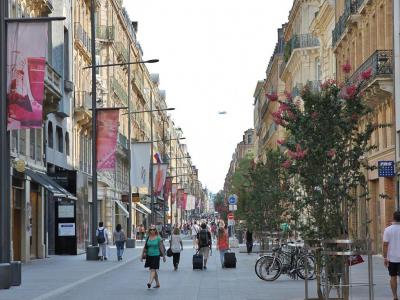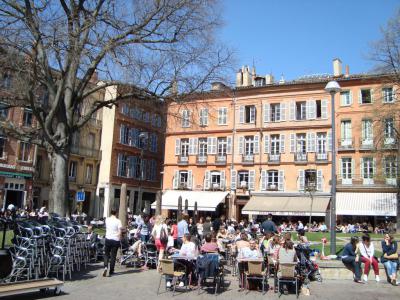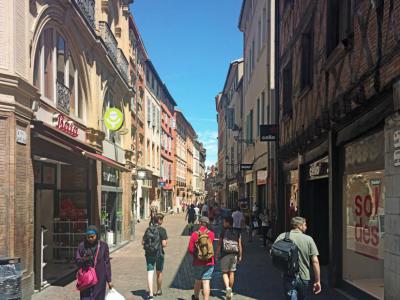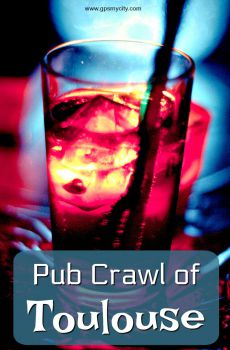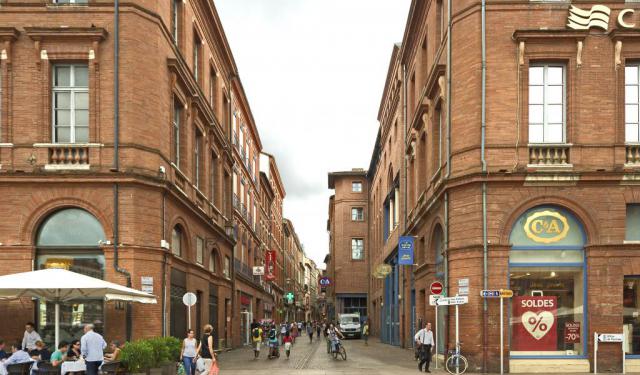
Toulouse Markets and Shopping Streets (Self Guided), Toulouse
Like many other cities in France and Southern France in particular, Toulouse boasts a delightful array of shopping areas. At Galeries Lafayette, a renowned department store, you can find exclusive French items for sale - no problem; however, to discover some truly great bargains – from organic vegetables to antiques, – a visit to Toulouse's street markets is a must.
One of the most iconic spots is the Victor Hugo Market, where you can immerse yourself in the vibrant atmosphere of traditional French retail. The abundance of fresh produce, cheese, wine, and artisanal products here makes it an ideal place to savor the region's flavors.
Strolling along Alsace-Lorraine Street (Rue d'Alsace-Lorraine), you can explore a variety of trendy boutiques, fashion stores, and charming shops specialized in local craftsmanship, making it a great spot for a leisurely shopping day out.
For art enthusiasts, Art Street (Rue des Arts) is a must-visit destination. This charming street is home to numerous art galleries and studios – a perfect place to discover unique pieces of art that capture the essence of Toulouse's creative spirit.
Place Saint-Georges, a lovely square, hosts a bustling market that adds to the city's lively atmosphere. This market features stalls selling clothing, accessories, antiques, and gourmet treats. It's a great spot to soak up the local culture and find some unique souvenirs.
Saint-Rome Street (Rue Saint-Rome) offers a diverse shopping experience with its mix of high-street brands and boutique shops. In this thoroughfare, you can shop for clothing, jewelry and more, while enjoying the architectural beauty of the historic buildings around.
The shopping tapestry of Toulouse is as colorful as it is diverse - fit to accommodate multiple needs, from art and high fashion to fresh produce and other delights. So, grab the opportunity and take this self-guided walk to explore these locations during your trip to Toulouse. Happy shopping!
One of the most iconic spots is the Victor Hugo Market, where you can immerse yourself in the vibrant atmosphere of traditional French retail. The abundance of fresh produce, cheese, wine, and artisanal products here makes it an ideal place to savor the region's flavors.
Strolling along Alsace-Lorraine Street (Rue d'Alsace-Lorraine), you can explore a variety of trendy boutiques, fashion stores, and charming shops specialized in local craftsmanship, making it a great spot for a leisurely shopping day out.
For art enthusiasts, Art Street (Rue des Arts) is a must-visit destination. This charming street is home to numerous art galleries and studios – a perfect place to discover unique pieces of art that capture the essence of Toulouse's creative spirit.
Place Saint-Georges, a lovely square, hosts a bustling market that adds to the city's lively atmosphere. This market features stalls selling clothing, accessories, antiques, and gourmet treats. It's a great spot to soak up the local culture and find some unique souvenirs.
Saint-Rome Street (Rue Saint-Rome) offers a diverse shopping experience with its mix of high-street brands and boutique shops. In this thoroughfare, you can shop for clothing, jewelry and more, while enjoying the architectural beauty of the historic buildings around.
The shopping tapestry of Toulouse is as colorful as it is diverse - fit to accommodate multiple needs, from art and high fashion to fresh produce and other delights. So, grab the opportunity and take this self-guided walk to explore these locations during your trip to Toulouse. Happy shopping!
How it works: Download the app "GPSmyCity: Walks in 1K+ Cities" from Apple App Store or Google Play Store to your mobile phone or tablet. The app turns your mobile device into a personal tour guide and its built-in GPS navigation functions guide you from one tour stop to next. The app works offline, so no data plan is needed when traveling abroad.
Toulouse Markets and Shopping Streets Map
Guide Name: Toulouse Markets and Shopping Streets
Guide Location: France » Toulouse (See other walking tours in Toulouse)
Guide Type: Self-guided Walking Tour (Sightseeing)
# of Attractions: 5
Tour Duration: 1 Hour(s)
Travel Distance: 1.2 Km or 0.7 Miles
Author: helenp
Sight(s) Featured in This Guide:
Guide Location: France » Toulouse (See other walking tours in Toulouse)
Guide Type: Self-guided Walking Tour (Sightseeing)
# of Attractions: 5
Tour Duration: 1 Hour(s)
Travel Distance: 1.2 Km or 0.7 Miles
Author: helenp
Sight(s) Featured in This Guide:
- Victor Hugo Market
- Rue d'Alsace-Lorraine (Alsace-Lorraine Street)
- Rue des Arts (Art Street)
- Place Saint-Georges (Saint-Georges Square and Market)
- Rue Saint-Rome (Saint-Rome Street)
1) Victor Hugo Market
In the midst of the city find the Victor Hugo (covered) Market. Where is it? No surprise, walk down Victor Hugo Street to Victor Hugo Place. Can't miss it. There is a ground floor with shops and a second floor with restaurants and cafes. Come early, they close at 2pm. It is possibly the most popular market in the city.
Over 80 stallholders hold forth with a cornucopia of fresh products. Let us count the ways. There are Fishmongers, butchers, tripe sellers (really?), and poultry. Vegetarians get greengrocers, bakers, pastry makers, cheese makers, and creamers, wine makers, etc. Eat there or try the restaurants on the upper floor ("first" floor in France).
The market opened in 1892. The Victor Hugo Market is host to more than a hundred friendly merchants, and restaurants. And there are nocturnal activities. English speaking tours are available. If one doesn't visit the Victor Hugo Market, they miss one of the best parts of Toulouse.
Over 80 stallholders hold forth with a cornucopia of fresh products. Let us count the ways. There are Fishmongers, butchers, tripe sellers (really?), and poultry. Vegetarians get greengrocers, bakers, pastry makers, cheese makers, and creamers, wine makers, etc. Eat there or try the restaurants on the upper floor ("first" floor in France).
The market opened in 1892. The Victor Hugo Market is host to more than a hundred friendly merchants, and restaurants. And there are nocturnal activities. English speaking tours are available. If one doesn't visit the Victor Hugo Market, they miss one of the best parts of Toulouse.
2) Rue d'Alsace-Lorraine (Alsace-Lorraine Street)
Alsace-Lorraine Street is one of the major shopping destinations in Toulouse. Until 1872, the street was known as Longitudinal Street, a temporary name used during the urban development stage. On November 26, 1872, it was renamed in memory of the two provinces – Alsace and Lorraine – lost to Germany in the Franco-Prussian War of 1870. After a thorough reconstruction that lasted almost ten years, Alsace-Lorraine Street was finally opened in 1873.
Along the way, the street provides access to several notable sites, primarily the Augustins Museum, the municipal repository of fine arts, occupying the former Augustinian convent.
Among other architectural jewels, there is the Consular Palace, originally a mid-17th-century private mansion. Over time, it underwent various transformations, serving different purposes, from a residence for archbishops to a commercial hub. In the early 20th century, it was remodeled, accommodating shops and a commercial museum. Its Neo-classical facade, a pastiche of 18th-century Toulouse architecture, stands out with its polychrome stone and brick composition.
The street also hosts major department stores like La Maison Universelle and Monoprix, each with a unique architectural style reflective of their respective eras. The Monoprix building, constructed in 1963, features a modern design with red brick facing, while Au Capitole, built in the early 20th century, displays Art Nouveau influences with its cast-iron and light brick structure.
In addition, several historical buildings line the street, such as the Grand Hotel Tivollier with its eclectic Haussmann style and the Art Deco Hall Dispatch, showcasing modernity with its striking blue mosaic facade. Each building on Alsace-Lorraine Street contributes to the architectural tapestry that characterizes this historic thoroughfare, making it a vital part of Toulouse's cultural and historical landscape.
Along the way, the street provides access to several notable sites, primarily the Augustins Museum, the municipal repository of fine arts, occupying the former Augustinian convent.
Among other architectural jewels, there is the Consular Palace, originally a mid-17th-century private mansion. Over time, it underwent various transformations, serving different purposes, from a residence for archbishops to a commercial hub. In the early 20th century, it was remodeled, accommodating shops and a commercial museum. Its Neo-classical facade, a pastiche of 18th-century Toulouse architecture, stands out with its polychrome stone and brick composition.
The street also hosts major department stores like La Maison Universelle and Monoprix, each with a unique architectural style reflective of their respective eras. The Monoprix building, constructed in 1963, features a modern design with red brick facing, while Au Capitole, built in the early 20th century, displays Art Nouveau influences with its cast-iron and light brick structure.
In addition, several historical buildings line the street, such as the Grand Hotel Tivollier with its eclectic Haussmann style and the Art Deco Hall Dispatch, showcasing modernity with its striking blue mosaic facade. Each building on Alsace-Lorraine Street contributes to the architectural tapestry that characterizes this historic thoroughfare, making it a vital part of Toulouse's cultural and historical landscape.
3) Rue des Arts (Art Street)
In medieval times the present Art Street was in two sections. First, Baragnon street, named for resident artisan basket makers. Cantegril street was Puits-des-Deux-Edges Street for the well at the intersection of Pomme Street and Fourbastard Street. In the 16th century tinsmiths and pewter smelters gave it the title of Estagneres-Vieilles.
In 1806 the street at last became the Art Street. The School of Fine Arts had moved into the buildings of the old Augustinian convent. Private mansions line the street, among them are: Nolet hotel; Depuy-Montard hotel and; Duranti hotel. Other building include: house at Croix-Baragnon; cordage at Cross street Baragnon and; the Calbairac building.
Strolling along, one will also encounter public works: Statue of Velleda, who died in an uprising against the emperor Vespasian in the year 70; The Xavier Durasse fountain, erected in 1992 in honor of Xavier Durasse, organist and composer.
In 1806 the street at last became the Art Street. The School of Fine Arts had moved into the buildings of the old Augustinian convent. Private mansions line the street, among them are: Nolet hotel; Depuy-Montard hotel and; Duranti hotel. Other building include: house at Croix-Baragnon; cordage at Cross street Baragnon and; the Calbairac building.
Strolling along, one will also encounter public works: Statue of Velleda, who died in an uprising against the emperor Vespasian in the year 70; The Xavier Durasse fountain, erected in 1992 in honor of Xavier Durasse, organist and composer.
4) Place Saint-Georges (Saint-Georges Square and Market)
Saint-Georges Square is named for a small chapel that was in the middle of the square. The chapel was moved hundreds of years ago to a corner of the street only to be demolished in 1808. The Square was once a popular locale for the burning of heretics during the Inquisition. No nostalgia for that "old time religion" here.
Prior to the French Revolution of 1794 the square was named Montaygon, after a local landlord. Come the Revolution the square was named Place Calas. Jean Calas was executed in the square. At one time the square was named for composer Paul Vidal. Vidal, happily, was not executed anywhere. Finally, in 1914, the City brought back Saint-Georges Square.
There is no shortage of good places to dine around the square. One may sit inside or outside. Outside is recommended for relaxed people watching. Every morning, except Sunday there is a farmers market in the Saint-Georges Square. Go early.
Prior to the French Revolution of 1794 the square was named Montaygon, after a local landlord. Come the Revolution the square was named Place Calas. Jean Calas was executed in the square. At one time the square was named for composer Paul Vidal. Vidal, happily, was not executed anywhere. Finally, in 1914, the City brought back Saint-Georges Square.
There is no shortage of good places to dine around the square. One may sit inside or outside. Outside is recommended for relaxed people watching. Every morning, except Sunday there is a farmers market in the Saint-Georges Square. Go early.
5) Rue Saint-Rome (Saint-Rome Street)
Saint-Rome Street (Rue Saint-Rome) is a historic pedestrian lane in Toulouse, quite pleasant to spend an afternoon shopping and snacking one's way from the Capitol down to Esquirol Street (Rue Esquirol). This thoroughfare, bustling with an array of stores, is lined with opulent facades of private mansions and merchant buildings dating from the 15th to the 19th centuries, reflecting the wealth of Toulouse's bourgeoisie. The architectural highlights here include the towers of the Serta and Roguier buildings (at No. 2 and No. 30, respectively), as well as the Comère and Comynihan hotels (at No. 3 and No. 21), symbolizing their affluent residents who often achieved significant civic status.
The street's name has its roots in the 12th century, originally associated with the Saint-Romain church, and has always been a favorite place to do business. The first major guild to settle here, back in the mid 1200s, was that of the butchers. The fishmongers followed soon after, but they didn't last long because of the smell that the locals didn't like too much.
Leather workers, who came afterwards, passed the smell test and were later joined by other artisans. From the 16th century onward, the street was firmly associated with the city’s merchant elite, including book printers and sellers, who established prestigious residences and participated actively in the vibrant trading tradition.
Multiple fires throughout the 15th and 16th centuries led to a shift from half-timbered houses to more durable brick structures. The street's socio-economic dynamics were further influenced by the French Revolution. During that period, in line with the nationwide trend, the street was briefly renamed Liberty Street (Rue de la Liberté). This name, however, didn't stick and in 1806 Saint-Rome Street reappeared.
In the 20th century, Saint-Rome Street continued to thrive as a commercial hub, influenced by nearby urban developments. It was designated as the city’s first one-way street in 1926 and continued evolving throughout the century with a focus on retail catering to younger demographics. The 21st century has seen the street adapt to changing commercial trends with the introduction of low-cost brands and mobile telephony shops. Saint-Rome's historical and cultural significance was officially recognized in 1986, ensuring its preservation as part of Toulouse’s remarkable heritage site.
The street's name has its roots in the 12th century, originally associated with the Saint-Romain church, and has always been a favorite place to do business. The first major guild to settle here, back in the mid 1200s, was that of the butchers. The fishmongers followed soon after, but they didn't last long because of the smell that the locals didn't like too much.
Leather workers, who came afterwards, passed the smell test and were later joined by other artisans. From the 16th century onward, the street was firmly associated with the city’s merchant elite, including book printers and sellers, who established prestigious residences and participated actively in the vibrant trading tradition.
Multiple fires throughout the 15th and 16th centuries led to a shift from half-timbered houses to more durable brick structures. The street's socio-economic dynamics were further influenced by the French Revolution. During that period, in line with the nationwide trend, the street was briefly renamed Liberty Street (Rue de la Liberté). This name, however, didn't stick and in 1806 Saint-Rome Street reappeared.
In the 20th century, Saint-Rome Street continued to thrive as a commercial hub, influenced by nearby urban developments. It was designated as the city’s first one-way street in 1926 and continued evolving throughout the century with a focus on retail catering to younger demographics. The 21st century has seen the street adapt to changing commercial trends with the introduction of low-cost brands and mobile telephony shops. Saint-Rome's historical and cultural significance was officially recognized in 1986, ensuring its preservation as part of Toulouse’s remarkable heritage site.
Walking Tours in Toulouse, France
Create Your Own Walk in Toulouse
Creating your own self-guided walk in Toulouse is easy and fun. Choose the city attractions that you want to see and a walk route map will be created just for you. You can even set your hotel as the start point of the walk.
Historical Churches Tour
Toulouse's historical center is full of architectural marvels, many of which are churches. The variety of basilicas, cathedrals, and cloisters built in the city throughout the 11th-19th centuries is complemented by the richness of styles serving as a testament to both faith and craftsmanship.
The 12th-century Basilica of Saint Sernin is a masterpiece of Romanesque design. It's known... view more
Tour Duration: 2 Hour(s)
Travel Distance: 3.2 Km or 2 Miles
The 12th-century Basilica of Saint Sernin is a masterpiece of Romanesque design. It's known... view more
Tour Duration: 2 Hour(s)
Travel Distance: 3.2 Km or 2 Miles
Architectural Jewels of Toulouse
It doesn't take an architectural expert to appreciate the beauty of Toulouse's historic buildings. Walking the city's streets one can't help admiring the galore of ancient architecture which has earned Toulouse, since as early as the 16th century, the title of "the most beautiful city in France".
Once a powerful provincial capital, Toulouse utilized its prosperity,... view more
Tour Duration: 2 Hour(s)
Travel Distance: 3.8 Km or 2.4 Miles
Once a powerful provincial capital, Toulouse utilized its prosperity,... view more
Tour Duration: 2 Hour(s)
Travel Distance: 3.8 Km or 2.4 Miles
Toulouse Introduction Walking Tour
Known affectionately as "The Pink City" (La Ville Rose) due to the terracotta bricks used in many of its buildings, the capital of the Occitania region of France – Toulouse – offers a blend of historical intrigue and modern dynamism. Originally known as Tolosa (the meaning of the name is unknown), it was established as a military outpost by the Romans in the 2nd century BC.
... view more
Tour Duration: 2 Hour(s)
Travel Distance: 3.1 Km or 1.9 Miles
... view more
Tour Duration: 2 Hour(s)
Travel Distance: 3.1 Km or 1.9 Miles
Useful Travel Guides for Planning Your Trip
Pub Crawl of Toulouse
There are some really great little pubs in Toulouse. This guide helps you find a few of the local favourites, one pint after the other. Discover good craic at Mulligans and The Killarney; be amazed at what's on tap at Bar l'Ancienne Belgique and Bar La Tireuse; and put the English back in...
The Most Popular Cities
/ view all

